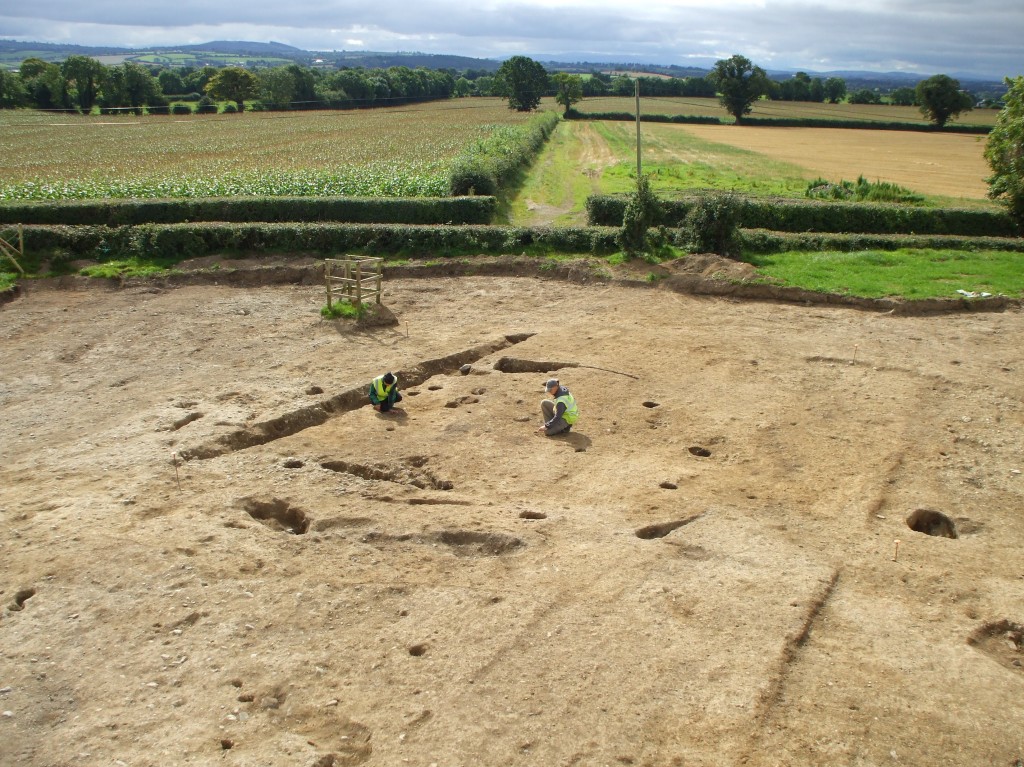Sixteen metres is not exactly a long distance. It is probably equitable to an average 1980s bungalow, yet the residents of a house in Mullaghmast Co. Kildare, sometime around 1350 BC, appear to have been interred in a penannular ring-ditch only sixteen metres from their home.
Rubicon’s Nial O’Neill excavated the house and penannular ring-ditch on behalf of the National Roads Authority and Kildare County Council as part of archaeological works on the N9/N10 Kilcullen to Waterford Scheme during the autumn of 2007. We knew we had discovered a Bronze Age house when we found a circle of postholes with some recognisable internal features- these included a fireplace, partitions and storage pits. The house itself was some 6.5m wide. We were able to use environmental material from one of the postholes to obtain a radiocarbon date of 1530-1300 BC.

We also discovered some indications of the daily life of the prehistoric people who once lived here. In one of the storage pits we found concentrations of hazel and oak. Hazel is well known for lighting quickly, while oak burns slowly while producing high temperatures- all that was needed for a quickly lit and long lasting fire. The pit also contained cultivated barley, wheat, oat and rye along with wild species. Both the cultivated grain and the wild grain was processed and ready for use. The fact that wild grain had also been collected and processed could indicate that the previous harvest may have been a poor one. The radiocarbon date from this pit was very similar to the one we achieved from the posthole, coming in at 1530-1310 BC. In addition, Middle Bronze Age pottery was recovered from some of the postholes at the site, supporting the radiocarbon dates.

The ring-ditch was discovered 16m away from the house.This monument type is associated with burial; cremated human remains are often found either in or around the ditch itself or within its interior- sometimes both. This example survived as a circular ditch in the ground, some 5.5m in diameter. It had a 1.5m wide entrance way facing southeast, with the discovery of some stakeholes suggesting there may have once been an entrance feature there. This may have been used to control movement in and out of the interior of the ring-ditch. The ditch was found to contain numerous stakeholes, further indication that some form of structure or barrier once stood here. Although on this occasion the ring-ditch itself contained only a small amount of burnt bone, several of the features inside, immediately outside and cut through the ring-ditch produced considerable volumes of human bone. Material recovered from the ring-ditch was dated to 1500-1210 BC, suggesting it may have been contemporary with the house. Further evidence for the people who once lived here was uncovered when a burial containing cremated bone was located a short distance outside the ring-ditch. This was radiocarbon dated to 1440-1190 BC, tying in very closely with the other results.
All the evidence indicates that these domestic and funerary monuments, located only 16m apart, were contemporary or near-contemporary with each other. Were those individuals interred in and around the ring-ditch also those who built and lived in the house? Were they the same people who had made and used the pottery, collected the wood and planted, cultivated, harvested and processed the grain? We will never know for sure, but it is certainly a possibility. If it was the case, these prehistoric people chose to live their lives beside the final resting place of their family, indicating the close bonds the living felt with the dead in Bronze Age Ireland.

Nice article. Are ye seeing beds against the ‘back’ wall? Approx 6 ft (old money) long hollows.
Also any conjoined pit groups emerging for food processing? I will post a example of what I mean and link to here in a few days.
Hi John,
Many thanks. We didnt get the hollows-the features in the foreground in the photo and contexts (010) and (054) as seen in the plan, are storage pits. These pits are those that contained the concentrations of oak and hazel and the grain referred to in the blog. None of the pits were conjoined though. It would be great to see the link to see the parallels and differences with your site though.
Pingback: Tweets that mention From Cradle to the Grave in Middle Bronze Age Co. Kildare | Headlines -- Topsy.com